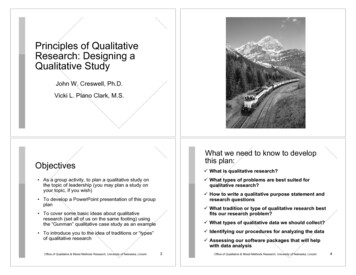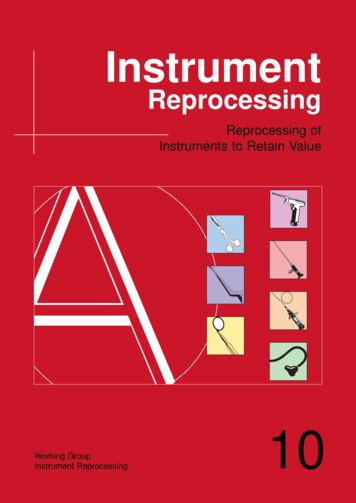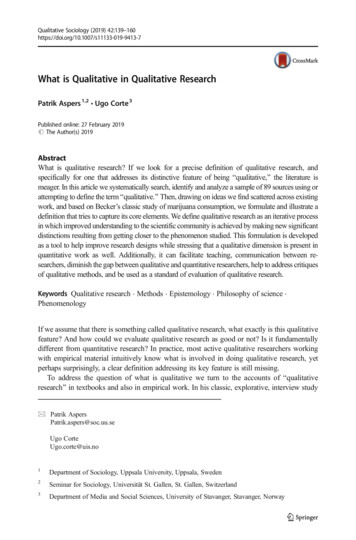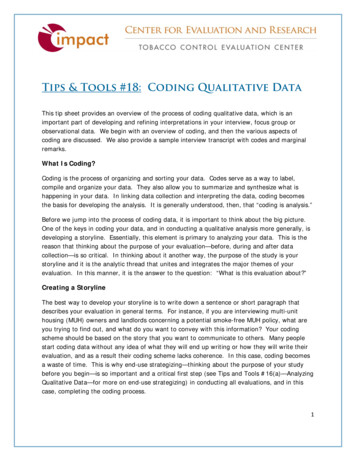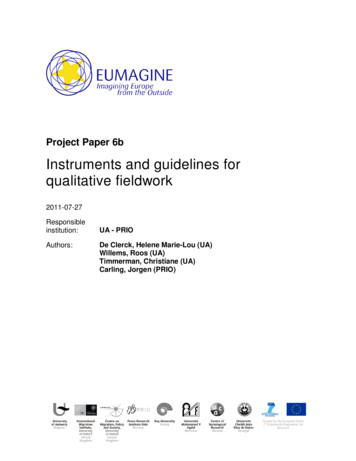
Transcription
Project Paper 6bInstruments and guidelines forqualitative UA - PRIODe Clerck, Helene Marie-Lou (UA)Willems, Roos (UA)Timmerman, Christiane (UA)Carling, Jorgen (PRIO)
EUMAGINE Project Paper 6BContentsIntroduction. 3I - Localities, researchers and informants. 4The locality for the qualitative field research . 4The qualitative researcher . 4The informants . 5II - Research guidelines for observations . 8How to observe: non-participant observations . 8What to observe . 8How to record observations . 10III - Research guidelines for interviews . 12Preparations. 12Semi-structured interviewing . 12The interview guide . 12Main topics . 13How to record the interviews . 15Guidelines for conducting the semi-structured interviews . 16The interview report. 18IV - The data . 19To be submitted. 19Transcription issues. 19Data entry: NVivo . 19V - Training sessions in qualitative research techniques . 20References . 21Annexes. 22TEMPLATE “Overview of potential informants” Page 1. 23TEMPLATE “Overview of potential informants” Page 2. 24TEMPLATE “Overview of potential informants” Page 3. 25TEMPLATE “Overview of potential informants” Page 4. 26TEMPLATE “Daily Observation Notes”Page1 . 27TEMPLATE “Daily Observation Notes”Page 2 . 28TEMPLATE “Daily Observation Notes”Page 3 . 29TEMPLATE “Observation Report” . 30TEMPLATE “Interview notes RESEARCHER”Page1 . 32TEMPLATE “Interview notes ASSISTANT”Page 1 . 35TEMPLATE “Interview report”. 382
EUMAGINE Project Paper 6BIntroductionOriginating in anthropology, qualitative field research traditionally refers to a practice in which researchers spend long periods living within a culture in order to study it. The term has been adoptedwithin qualitative market research to describe occasions where researchers spend time - hours,days or weeks - observing and/or interacting with participants in areas of their everyday lives. Thiscontrasts with interview-based research or surveys (quantitative data collection) in which interaction with respondents is limited to a conventional interview on the basis of a questionnaire andwhere interaction is limited in time.This Project Paper consists of five parts which together constitute the instruments and guidelinesfor the EUMAGINE qualitative field research: I) Localities, researchers and informants; II) Research guidelines for observations; III) Research guidelines for interviews: IV) The data; and V)Training sessions in qualitative research techniques.The qualitative field research in the EUMAGINE project consists of two equally important aspects:observation and interviews. While some aspects of the research topics may be sufficiently covered by interviews with informants, others will have to be observed by the researcher in the field.An interview guide and scenario for the observation and the interviews are elaborated, partly onthe basis of the quantitative data collected during the first half of 2010. However, the proposal(suggested at the kick off meeting in Antwerp) to locate the persons to be interviewed for the qualitative data collection among those persons that have participated in the survey (quantitative datacollection) was not withheld for two reasons.1 First, choosing informants from among the surveyrespondents may be considered a breach of confidentiality by some, and secondly, the purpose ofthe qualitative data collection is not to further explore individual factors of migration motives. Whileinformants may include persons who have responded to the survey, the information in the two datacollection formats will not be linked.1In conformity with standard social sciences practice, persons interviewed using qualitative research methods will becalled informants, while persons interviewed through the survey (quantitative method) are called respondents.3
EUMAGINE Project Paper 6BI - Localities, researchers and informantsThe locality for the qualitative field researchEach research team will autonomously choose one locality per Research Area (RA) to do thequalitative data collection. This locality will be chosen in function of its representativeness for theentire RA.Should it prove impossible to locate a sufficient number of informants corresponding to the selection criteria within one locality, research teams are free to move on to other localities within thesame RA. If a team decides that for the sake of representativeness, they need to cover severallocalities within the RA, they are free to do so when resources permit.It is recommended that one person month be spent in each of the research areas for the qualitative data collection with an absolute minimum of 2 weeks. The period allotted for the preparationand collection of the qualitative data in the DOW (WP6) are months 17 till 25 (June 2011 up toJanuary 2012).Once in the locality, it is important for the researcher to identify and gain access to the communitywhere the data collection will take place. In some places, local officials will need to be contacted toobtain approval and support for entering. Local researchers or other professionals familiar with thelocality are very important in helping to locate a variety of entry point into the community.The qualitative researcherGenerally, qualitative field researchers bring with them few inducements for local people to cooperate with them other than the opportunity to build a trusting relationship and talk about topics ofmutual interests, especially when the stay in the field is limited and when participant observation asa data collecting method is not applied, as is the case for EUMAGINE.Effective qualitative field researchers are those that build relationships easily, are sensitive to theirsurroundings, and who have few reservations about asking questions that enable them to learnnew things; however, without transgressing the social norms of the community.Researchers should also be able to separate stereotypes, and personal opinions and judgmentsfrom accurate observations and effective recording of wording, meanings, and opinions of researchparticipants.For the EUMAGINE project, each qualitative field researcher must be a researcher or graduatestudent, who is a member of the EUMAGINE team with an academic interest in the researchtopic, and who will be involved in writing analytical parts of the research project. Selecting qualitative field researchers should therefore be linked to the team’s overall writing and publicationplans.4
EUMAGINE Project Paper 6BThe informantsResearchers will need to spend time interacting with people and building a personal network in thecommunities in order to identify suitable informants for interviewing. Qualitative field researchersneed to understand the importance of reciprocity in building relationships. Thus, they may sharetheir time, transportation, knowledge, relationships with service providers or other resources valuable to the research participants and the communities. Usually, however, social skills and intellectual persistence and personal good may be even more important.The experience of most qualitative field researchers is that the explanation of the project is oftenconsidered less important by the people of the community. More important are the connectionsthrough which the researcher has been introduced to the community setting, how comfortable s/heis with the people in the field, and how well s/he can maintain confidentiality. The researcher’s appearance, use of language (including humour), perceived comfort level, growing knowledge of thesetting, and reactions to difficult or challenging new situations are all important in building the personal relationships necessary for effective field research.Selection criteria for intervieweesAccording to the DOW (P.16), a total of 20 (twenty) informants needs to be interviewed per RA.All informants may be chosen from the one locality (or more localities) representing the entire RA.Informants who spend a lot of time in the selected locality (f.e. because of professional activities)but who reside/live/sleep in another area: can be interviewed as informants of the selected locality.In this case they will be included in the list of informants of the RA where the interview tookplace.The strategies applied by the researcher to locate the 20 informants need to be documented inpoint 4 of the observation report (see separate section).Each group of 20 informants per RA needs to be diverse in five aspects:1.2.3.4.Gender (approximately half men and half women)Age (young and old within the range of 18 to 39 years old)Occupational status (unemployed, employed in various occupations)Migration experience (with and without a personal migration experience, having friendsand/or relatives with a migration history, belonging to transnational migration networks)5. Migration attitudes (aspiring or not aspiring to migrate)Since this is not a survey, we are not looking for representativity in numerical terms. The importantpoint is to cover a variety of situations and experiences. Suitability of potential informants is notonly a question of having specific characteristics with reference to these criteria, but also personality and openness. Annex 1, “Overview of potential informants”, is a template to help the researchers select informants with the dimensions of diversity in mind. It will probably be necessaryto consider a large number of informants in order to complete the 20 interviews — some will turnout to be less relevant, some will refuse to be interviewed and some will agree but never turn up tothe appointment. The overview therefore has space for 60 potential informants.5
EUMAGINE Project Paper 6BSpecial category of informants: immigrants, including transit migrantsWe decided that in the context of the EUMAGINE project we will not use the term ‘transit migrants’,instead we will use the term immigrants for every person who – or whose parents – immigratedfrom abroad regardless of their migration aspirations.The methodological note on quantitative research suggested that, because the survey was not theideal tool to explore the characteristics of immigrants – including ‘transit migrants’, the qualitativeresearch part of the project should take up these populations. In general, immigrants may be partof the group of informants in those RA’s with a high immigration rate, and as such contribute to thediversity of informants interviewed. In view of the low percentages of transit migrants and immigrants in the first analysis of the quantitative data, care should however be taken that they are notoverrepresented in the samples of the qualitative field research.Nonetheless, should national research teams decide that there is a particular concern with thesepopulations in their country, it is recommended they explore possibilities for researching immigrants and/or transit migrants in separate case studies (e.g. by a PhD student) in association withthe EUMAGINE project. This is for example already the case at UA, where Helene Marie-Lou DeClerck shall do her PhD research on Senegalese immigrants in Istanbul (Fatih). The EUMAGINEbudget cannot cover such additional research, so this is not something that is expected or requiredof the teams to do. (E.g. Helene’s sample of immigrants for her PhD will not be part of the samplefor the EUMAGINE project database.)Some research teams may decide to add “nationality/country of origin” as an extra selection criterion when locating informants in the RA with a high immigration rate, when deemed necessary fortheir research purposes.Strategies for locating informantsInformants will need to be located through exploratory conversation with persons encountered during the fieldwork at the respective localities through a variety of entry points. Approaching potential informants through multiple points of entry is essential in order to ensure the diversity withineach group of 20 informants.The best strategy for researchers is to find out whom they must meet to gain access to a specificresearch environment (also called gate keepers). These could be local politicians, or informal leaders, community health workers, teachers, NGO program directors, etcetera. However, it mightequally well be influential persons without formal positions—e.g. a housewife who is central to theinformation flows in her neighbourhood, or the man behind the counter in the local café. Whilethese individuals may or may not be useful sources of information, they can facilitate or block access to other members of the community. If the researcher succeeds in building good relationships with such persons, these may become effective key informants because of their broadknowledge of the research setting or their deep knowledge of an important aspect of the researchtopic. Key informants are not only useful for soliciting a lot of information on the research topic,they are also essential in locating other informants through their connection with and knowledge of(sections of) the community. However key informants should not be confused with the informants,and thus not be included in the sample of informants. Yet, conversations with key informants may6
EUMAGINE Project Paper 6Bgive a lot of interesting information. Therefore, information on and acquired through the means ofthe key informants should be noted down in the observation notes (see II. Research guidelines forobservations).7
EUMAGINE Project Paper 6BII - Research guidelines for observationsHow to observe: non-participant observationsObservation refers to what can be seen through the eyes of the observer.Aims: 1) observations will help to select the informants for the interviews; 2) the recorded observations will result in the observation report per research locality providing an in-depth description ofthe context of each locality.Participant observation is the data collection technique that requires the researcher to be presentat, involved in, and recording the routine daily activities with people in the field setting.Although participative observation offers some advantages, this technique is time consuming.Given the time constraints of the project we will therefore not make use of this tool of observation.Instead, non-participative observation or observation from a distance will be used as tool of observation.Non-participant observation or observation from a distance refers to the researcher’s longdistance observation of activities related to the topic of interest. It is a form of observation that isspectator-like; not participatory. Observation from a distance is only possible when it can be conducted unobtrusively, in such a way that participants do not notice the researcher.What to observeRole of migration in the development of the localityResearchers will observe outward signs of the effects of migration on the daily life in the localcommunities, such as for example: prevalence of empty houses due to owners having migrated; prevalence of houses being constructed or renovated by migrants or their families; possible differences between houses of non-migrants versus migrants (style, standing,size, etc.); presence of businesses with names of foreign countries/cities that are destinations for migrants (e.g. ‘Café Napoli’); presence of advertising linked to migration (e.g. Western Union, etc.); presence of advertisements for money transfer services such as Western Union, MoneyGram; presence of businesses that provide money transfer services; presence of businesses for international phone calls, international travel, etc ; more signs of the material culture of migration: cars with foreign license plate, shops thatare unusual for a standard locality in the RA (f.e. shops with luxury items that normally canonly be find in large cities).8
EUMAGINE Project Paper 6BHuman rights and democracy issuesResearchers will observe the outward signs of the presence of human rights and/or democracyissues in the locality. Indicators may be, for example: visibility of local public services (services for health care, education, different political associations ); local offices of human rights organizations or ‘community building’ initiatives (e.g. promotion of women’s rights, educational, health projects ); the functioning of local authorities (visibility, accessibility by the public, possible personalexperiences); presence of police or the military on the streets; visible signs of politics in the community (posters, slogans on walls, etc); the level of (dis)trust encountered in personal experiences with local persons; the general atmosphere in the locality (sense of optimism/pessimism).Socio-economic situation of the localityResearchers may observe a multitude of outward signs indicative of the level of poverty of the localcommunity, such as: the state of local infrastructure (road, public services, etc);the number of dilapidated buildings (government buildings, private houses);presence of construction activities (roads, official buildings, private houses);the presence and age of transports means (private cars, public transport);the presence of (international or local) development agencies/NGOs.Other observations not covered by the 3 main topicsInformation acquired through conversations with local people, local authorities orkey informantsObservations come not only from seeing but also from hearing, e.g. conversations with local people or with key informants. The information obtained through these conversations has also to bereported in the observation notes.9
EUMAGINE Project Paper 6BHow to record observationsThe use of observation notesThe researchers will record their daily observations in the research localities using observationnotes, which constitute a scientific record of the experience for future reference. The more complete and accurate the observation notes, the easier it is for the researcher to use them. Writinggood observation notes involves detailed and concrete observation on a regular basis.Observation notes will include1. observations on the main topics to be observed (role of migration in the development of thelocality; human rights and democracy issues; socio-economic situation of the locality);2. other observations made by the researcher that are not covered by these main topics;3. information acquired through conversations with local people, local authorities, key informants;4. researcher’s personal comments.While 1), 2) & 3) are objective observations made by the researcher, 4) includes inferences andpersonal observations, reflections and emotional reactions of the field researcher. The subjectivecomments will be recorded separately from the objective observations (template “daily observation notes”).Ideally, the researchers will record their observations daily. In the research field small notebooksand pencils/pens are useful for helping the researcher to record their observations. Once at home,they should transform their shorthand notes into detailed descriptions on the computer (using thetemplate “daily observation notes”) as quickly as possible. Although memory and recall improvewith practice, no researcher should depend on memory alone for reconstructing field notes, because memory is selective and easily biased, and recall diminishes notably, even on importanttopics, after 24 hours. The daily observation notes will be used by the researchers as one of thesources for writing the observation report for each locality. Meanwhile they remain importantsources of the analyses. Observations notes may be written in the local language, but before attaching them to the Observation Report they have to be translated into either English or French.The researchers should also take pictures of the RA to complement the observation notes. In order to preserve confidentiality, do not include informants in the pictures. The camera should be setto high resolution (usually called “L” for large) so that the photos can be used in print. The reportmust include the name(s) of photographer(s).The observation reportTeams need to write an observation report for each locality where the qualitative research wasconducted (4 observation reports in total per team). These reports will provide an overview of theobservation process in the RA and a description of the context of each research locality, and mustinclude:10
EUMAGINE Project Paper 6B1.2.3.4.5.6.background about the fieldwork;an introduction on the locality (localities) where the research was conducted;a summary of the observations on the role of migration in the development of the locality;a summary of the observations on human rights and democracy issues in the locality;a summary of the observations on the socio-economic situation of the locality;a summary of the other observations made that are relevant for the research locality but notcovered by the topics 3 to 5;7. a summary of the information on, and acquired through the means of conversations with local people, local authorities and key informants8. a description of the strategies used to locate the informants;9. ANNEX: the daily observation notes;10. ANNEX: pictures of the RA’s.These reports will be based on both the researchers’ daily observation notes as well as the interactions of the researchers during fieldwork (template “observation report”), and will be written inFrench or English only.11
EUMAGINE Project Paper 6BIII - Research guidelines for interviewsPreparationsAccording to the DOW (p.11) the interview guide needs to be developed on the basis of the firstdata analyses of the survey data. While we do not have substantial results in time, the interviewguide is designed to facilitate mixed-methods analysis that draws upon the project’s qualitative andquantitative data.The English interview guide will be translated into the same languages as used for the survey,preferably by the same translators. There is no need for back translation.Teams are requested to do one pilot interview per researcher with the final interview guide before the training, so as to exchange on results and experiences during training.Semi-structured interviewingThe interview guide is an instrument for the researcher to ensure that none of the important issuesto be discussed is left out of the conversation. The format of the interview itself will be that of asemi-structured interview. Semi-structured interviews combine the flexibility of the unstructured,open-ended interview with the directionality and agenda of the survey instrument. The topics of asemi structured interview are pre-determined, but most of the questions are formulated by the researcher in the interview setting. This researcher is attentive to what the interviewee says, andresponds with follow-up question and probes.The interview may last from approximately 45 minutes to up to 2 hours, depending on the settingand the responsiveness of the informant. For interviews in local languages not mastered by theresearcher, an interpreter will be used in the field.The interview guideAn interview guide for semi-structured interviews is fundamentally different from a questionnaire. Itis not a list of questions, but a guide to a dynamic conversation. Importantly, our guide is a singlesheet of paper. There are two reasons for this:First, it allows researchers to focus their attention on the informants and what is being said. Sincethe researcher are not flicking through papers and reading from a list, we avoid a situation in whichinformants give short answers and wait for ‘the next question’.Second, semi-structured interviews always require that researchers are well prepared and knowthe aims of the interview by heart. Only in that way is it possible to respond adequately to what theinformant is saying.12
EUMAGINE Project Paper 6BThe interviews will have four main topics, outlined below. For each topic, we have formulated asuggested opening question and a list of sub-topics. The guide should be used in the followingway:Main topics All the four main topics must be covered They should preferably be covered in the given order They should preferably be introduced with the given questionsSub-topics The sub-topics are suggestions, not a compulsory list Other interesting sub-topics could follow from what the informant saysThe order of sub-topics should be flexible Whenever possible, introduce sub-topics with reference to what the informant has saidFor example, the answer to the opening question about life in the locality is likely to contain somemention of possible sub-topics (e.g. jobs). The researcher should improvise follow-up questions onwhichever sub-topics are mentioned. Later in the interview, it is also possible to make such connections: “In addition to the lack of jobs, you mentioned the problems with health care. Could you saymore about that?” “You did not say anything about how easy or difficult it is to find jobs in this area. Could youtell me about that?”The sub-topics are not just a list of themes, but also suggested perspectives on the themes thatare discussed, e.g. changes over time and differences between men and women. Researchersmust be attentive to when and how it is interesting to raise these questions.Main topics1. Perceptions of life in the localityWe are interested in how informants perceive life in their own locality? What do they see as goodand bad aspects of living in the locality? This topic includes human rights — covering both the‘negative’ and ‘positive’ definitions (see “EUMAGINE Methodological notes on sampling, measurement and operationalisation” by IMI in Annex 9 of the Kick Off meeting report which can befound in the Document library). How to bring up human rights and democracy needs to be plannedcautiously on a case-by-case basis, bearing in mind the need for recording interviews. Given ourbroad approach to the topic, it might not be necessary to use the term ‘human rights’. Recall that inthe survey, we addressed human rights by asking about the following issues: The life of women The life of men The quality of schools The quality of health care13
EUMAGINE Project Paper 6B Help from the government for poor people The extent of corruption Whether politicians do what is best for the people Whether or not it is easy to find a good job Whether or not it is dangerous to walk in the street at night Whether or not women have the same opportunities as menWhether or not people can say whatever they want in public Whether or not the government respects the different languages that people speak Whether or not people can get ahead by working hardThese themes are equally relevant to the semi-structured interviews. It is deliberate that the term“human rights” is not used on the interview guide that researchers carry around with them.2. Perceptio
The locality for the qualitative field research Each research team will autonomously choose one locality per Research Area (RA) to do the qualitative data collection. This locality will be chosen in function of its representativeness for the entire RA. Should it prove impossible to locate a sufficient number of informants corresponding to the .


